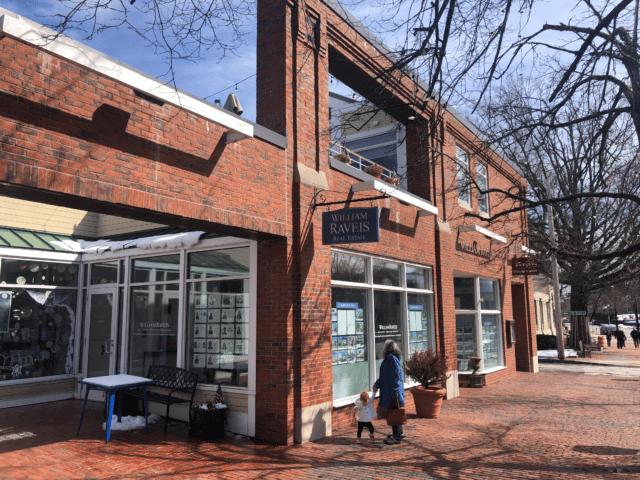As 175 Massachusetts communities grapple with the requirements of the state’s new Housing Choice law, the town of Lexington illustrates the potential major changes to the local landscape needed to meet its housing production goals.
The Planning Board’s initial proposal would double building heights from 30 to 65 feet in Lexington Center to accommodate 6-story apartment or condominium buildings with ground-floor retail. The changes would apply to 25 acres that comprise the bulk of the town center, a stretch of Massachusetts Avenue lined with 1- to 3-story retail buildings and rear parking lots.
“We looked at our [MBTA] bus lines and looked at our big commercial areas, and it becomes pretty clear what the choices are,” Planning Board Chairman Charles Hornig said last week.
Even if approved, the Lexington Center rezoning wouldn’t come close to hitting the town’s obligation, officials acknowledge, potentially generating just a third of the nearly 2,500 multifamily units required under draft state regulations. Some residents think a broader approach – such as allowing duplexes and condos in single-family zones – should be on the table.
“You could take one of these big houses, do a condo conversion and split it into two units,” said Jeff Lyon, owner of W.H. Lyon Realtors Inc. in Lexington. “There’s your answer to [creating] more housing.”
Reaction to the Planning Board’s proposal was mixed at a recent virtual hearing. Some residents spoke in favor of increasing housing affordability, in a community where the median single-family home sale price hit $1.3 million in January, according to data compiled by The Warren Group, publisher of Banker & Tradesman.
But one resident blanched at the board presentation’s description of an “urban town center” displacing the “nice Colonial town” and others asked for a cost-benefit analysis of housing’s effects on the public-school budget.
Another resident said a future infusion of residents in new multifamily building could help diversify the mix of retail tenants, and attract alternatives to the bank branches and realty offices that dominate the center’s storefronts.

Lexington officials are proposing 65-foot building heights and adding multifamily uses to the town center to comply with a new state law requiring the town to create zoning that would allow nearly 2,500 apartments or condos. Photo by Steve Adams | Banker & Tradesman Staff
Heights Raised to Boost Businesses
The Lexington Planning Board identified Lexington Center last year as the first potential location for complying with the Housing Choice law, which was signed by Gov. Charlie Baker in February 2021, and hailed by housing activists as a milestone in breaking down suburban zoning barriers to housing production.
The law requires the 175 cities and towns with MBTA service to rezone a minimum of 50 acres for multifamily development by-right at a minimum density of 15 units per acre. And it sets new minimums for multifamily units as a percentage of a community’s overall housing stock: from 10 percent for “adjacent” communities with no direct MBTA service to 25 percent in those with subway or light rail stops.
Lexington and 34 other communities that only have MBTA bus service are required to enact zoning that would enable multifamily units to comprise 20 percent of its housing stock. The Planning Board recommended 65-foot building heights because 6-story buildings are the maximum allowed for wood-frame construction, which is favored by developers because of its lower costs than steel-framed buildings, said Michael Schanbacher, an architect and board member.
Mixed-use buildings including apartments were a feature of Lexington Center until zoning regulations prohibited them in the mid-20th century, noted Lyon, the Realtor. Built in the 1890s, the 2-story retail building at 1752-1768 Massachusetts Ave. that’s currently anchored by Rancatore’s Ice Cream shop included high-end apartments including butler’s quarters, before being converted into office space in the 1960s, Lyon said. Other properties on side streets contained duplexes and single-family homes through the 1960s and 1970s.
The commercial district is significantly less lively compared with those in similar wealthy suburbs because of its heavy presence of banks and professional offices, noted Lester Savage, a prominent Realtor with Berkshire Hathaway Commonwealth Real Estate in Lexington.
“The center is undergoing a major streetscapes reconstruction project, so that’s a part of it. But we were having problems before keeping small businesses and things that weren’t banks and real estate offices,” Savage said.
Densify Districts or Double Up Houses?
Officials have not proposed any other areas for rezoning, but the Planning Board’s Hornig said existing commercial districts near Route 128 have come up in discussions.
“There are certainly people who think Hartwell Avenue or Bedford Street would be appropriate,” he said.

Steve Adams
Jim Shaw, publisher of the Lexington Times and a former chamber of commerce president, said rezoning a single area such as Lexington Center misses opportunities to diversify housing stock town-wide.
“We can build tasteful two-family homes in almost every single part of the community,” Shaw said. “We’ve been woefully short on the issue of affordable home ownership. An apartment for a transient individual is not the same as an affordable home they can buy and put roots down, and not have a fear of having to move somewhere down the road.”
MBTA bus service communities have until Dec. 31 to submit action plans to DHCD and a December 2023 deadline to enact the multifamily-friendly zoning. The law threatens communities that don’t comply with loss of state funding, including MassWorks infrastructure grants.
Jerry Michelson, whose family-owned store Michelson’s Shoes has operated for more than a century in Lexington Center, predicted officials will have a tough sell for the rezoning concept, which requires town meeting approval.
“There is a lot of reaction in town saying, `We’re not ready for this,’” Michelson said. “People generally like the idea of more vibrancy and mixed uses, and the question is what is going to be the right height that the community will accept, and will that height be buildable and financially acceptable for anyone to even want to try it?”




 |
| 

